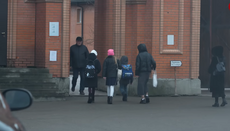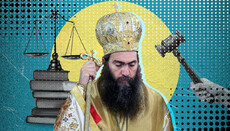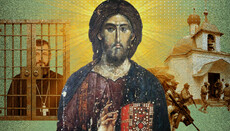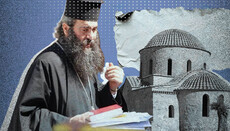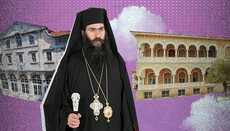Maker of alternative reality: 5 facts of Dumenko's lies at OCU "Council"
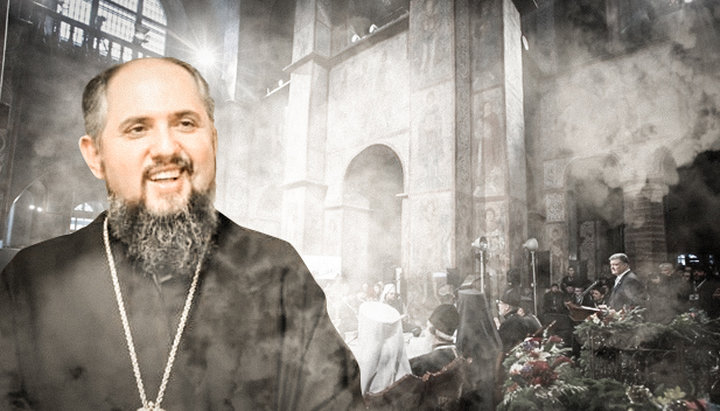
Sergei Dumenko made a number of out-of-touch-with-reality statements at the "bishops' council" of the OCU. Why does the head of OCU tell a lie and for what purpose?
On December 15, 2020, on the occasion of the second anniversary of the founding of the OCU, the “bishops' council” took place in this structure. The head of the OCU Sergei (Epiphany) Dumenko made a speech at the said event. It contains a lot of mind-boggling theses, e.g. the OCU is the largest religious organization in Ukraine, and the communities of the UOC do not want to join it, because new churches are built for them, and the main task of the OCU is to be a guardian of the religious peace in Ukraine.
You will agree that for any person even remotely familiar with the religious situation in our country, such statements voiced by the leader of the new religious structure sound weird and even funny. They not only contradict the facts and common sense, but also the elementary concept of truth. Anyway, in order not to be unfounded accusers – let's turn to the facts.
OCU is the largest Church in Ukraine?
In his final report at the “council” of the OCU, Sergei Dumenko said that its structure “remains the largest religious organization in terms of its number (!) and support it enjoys in Ukraine”. A very bold statement. Let's try to figure out how true it is.
We know that the size of the Church is determined by its believers – those who confess, receive the Holy Communion, and participate in the life of the community. As you know, believers unite in communities. And it is they who determine the size of the Church. There are statistics on the number of parishes, priests, dioceses, monasteries, etc. It is on the basis of such figures that conclusions are drawn about the size of a particular religious organization.
Dumenko cites the numbers of OCU communities “over 7000”, clergy “over 4500”, monasteries “about 80”. The head of the OCU, however, does not mention the number of "monastics" at all.
For comparison, in the Ukrainian Orthodox Church, according to the report as of 2020 of the Chancellor of the UOC, Metropolitan Anthony of Boryspil and Brovary, there are 12,374 parishes, 12,456 clergy, 255 monastic monasteries, 4,548 monks, 109 bishops, and 1,531 seminary students of religious institutions.
For clarity, let's compare the indicators of the UOC and OCU in the table. Let's at once make a reservation that the UOJ does not consider the members of the OCU either bishops or priests, therefore the table is rather arbitrary:
|
2020 year |
UOC |
OCU |
|
Parishes |
12 374 |
round 7000 |
|
Clerics |
12 456 |
round 4500 |
|
Hierarchs |
109 |
60 |
|
Monasteries |
255 |
round 80 |
|
Monks |
4548 |
??? |
What immediately catches your eye?
- The UOC has almost twice as many parishes as the OCU (we will analyze below how the figure of 7000 parishes in the OCU emerged), 2.5 times more priests. Accordingly, the OCU cannot be the largest in terms of numbers.
- The words “above” and “round” used in the official report of the “Primate of the Local Church”. For example, what does “round 80 monasteries” mean?! How can the primate not know their exact number?
- Absence in the report of the number of “monastics” of the OCU. At the time of the creation of this structure, according to the Department for Religious Affairs, there were 230 monks in the statistics of the UOC-KP, and 18 monks – in the UAOC. Therefore, let us help Sergei Dumenko with relevant figures. Its structure should include 248 "monks", which is 18 (!) times less than in the UOC. And if we divide the number 248 by “round 80 monasteries”, then we get the figure 3.1 – exactly as many “monks” fall on each monastery of the OCU. How plausible is this at all? It is up to the reader to decide.
Does OCU have "over 7000" communities?
We know that the OCU was formed by merging the structures of the UOC-KP and the UAOC. According to the Department for Religious Affairs, headed by Andrei Yurash, at the time the OCU was founded, there were 5,363 communities in the UOC-KP, 1171 in the UAOC. Together – 6,534. Another 84 voluntarily transferred from the UOC. Perhaps a dozen or two more churches were built in the OCU in two years. But where did “over 7000” come from?
You can recall the victorious reports of Dumenko in January-February 2019 that more than 600 communities of the UOC allegedly transferred to the OCU. This was reported despite the fact that the UOC itself provided very specific figures: 84 communities voluntarily transferred to the OCU, 122 churches were seized, 220 communities were illegally re-registered in favor of the OCU (i.e. the parishes continue to remain under the jurisdiction of the UOC). It is not difficult to assume that Sergei Dumenko didn’t bypass a small falsification: he summed up all these figures, added them to the OCU statistics and added a couple of hundred for the round figure. Here you are with "over 7000" communities.
If we take into account that the number of churches should correspond to the approximate number of priests (the UOC has 12374 communities and 12456 priests), it becomes obvious that Sergei Dumenko, voicing the number of 7000 parishes for 4500 priests, is telling an outright lie. In fact, it is unlikely that its structure has more than 4500 actually functioning communities.
Does OCU have the biggest amount of parishioners?
Dumenko writes in his report: “Social studies show that according to various estimates, from 65 to more than 75% of respondents belong to the Orthodox faith in Ukraine. Most of those who have made up their mind on their confessional and jurisdictional affiliation declare their affiliation with the OCU. In all regions, except for the East, the number of supporters of the OCU significantly prevails over the number of supporters of the Moscow Patriarchate – even where the current parishes of the OCU are in the minority. Among the Orthodox Christians surveyed, their identification with the Orthodox Church of Ukraine has increased by a third compared to last year."
In other words, Sergei Dumenko determines the number of the OCU believers by opinion polls. We do not know who conducted these polls (Dumenko is silent about this), among whom, how the questions were formulated, how many people were interviewed, etc. The head of the OCU simply offers to take at his bare word.
To see how plausible the results, on which Sergei Petrovich relies, we will refer to another Dumenko’s quote about the trust of Ukrainians in his person: “Among the OCU believers, 83.2% trust the Primate, and only less than 3% do not. More than 70% of supporters of the UGCC trust him, and he even has confidence of 38% supporters of the Moscow Patriarchate in Ukraine." The Moscow Patriarchate in Ukraine is – as you might easily guess – the UOC. We offer believers a small experiment – to come to their church and interview the parishioners of their community: do they trust Sergei (Epiphany) Dumenko. It seems that the result is unlikely to correspond to the 38% figure presented by the head of the OCU.
Another important point – Dumenko says that the number of those who identify themselves with the OCU (obviously, he is talking about the parishioners of his structure) has grown by a third over the past year. But the quantitative indicators of his structure have not changed in any way over the year. There are still "over 7000" parishes. Where do all these newly arrived OCU supporters go to pray? An elementary insight into the religious situation suggests that all the figures provided by Sergei Dumenko sound extremely improbable. And it looks even stranger to hear the person who positions himself as “the head of the local church” speak up so.
But in the Church, the number of those who attend worship is not even so important as their willingness to listen and fulfill the word of Christ.
In 2019, Dumenko said: “We must also be aware of the fact that a fairly significant part of those who call themselves Orthodox are Christians with little or no practice at all. That is, by the fact of their baptism, by self-identification, they belong to the Orthodox Church, however, they either only occasionally participate in divine services and the life of local church communities or they can at best only visit the church on Easter and order services."
In other words, Dumenko openly says that there are a lot of those in his structure who cannot be called churchgoers – these are, for the most part, people whose faith is limited to the primitive ritual side. It is clear that they will not come either to "divine services" or to participate in the "sacraments" of the OCU (except for the required ones). In the same way, they will not pray or participate in the life of the "church". These are ordinary "Orthodox atheists". Hence, there are explicitly raider operations during the seizure of Orthodox churches, bats, fittings, brass knuckles, clubs, crowbars, beaten UOC believers, church doors cut off by grinders and maimed with sledgehammers.
Another problem arises – having taken away the temple from the canonical Church, these people leave it empty. In the same way, having registered a community, they, in most cases, seek to take away an Orthodox church, and if this fails, then the matter does not go further than registration, while the OCU “community” exists only on paper.
OCU – a fighter for interfaith peace?
Yet, all of Dumenko's statements and figures are overshadowed by his words that “preserving interfaith peace in Ukraine, preventing the incitement of hostility and confrontation on religious grounds is an important task for our Church, which, being the largest religious association, has a corresponding duty to society."
We all know the expression "Bees against honey" – a fairly common meme, an oxymoron, an example of mutually exclusive theses. It is probably difficult to think of a more appropriate commentary on Sergei Dumenko’s words. If we recall January-February 2019, when representatives of the OCU, together with Poroshenko-led authorities, almost daily seized the temples of the UOC, then this expression of Dumenko is simply striking in its cynicism. Both the UOJ and other resources abound with hundreds of publications, photographs and videos where we can see with our own eyes this very “preservation of interfaith peace in Ukraine” performed by members of the OCU.
And literally three days before the "Bishops' Council" and the second anniversary of the creation of the OCU, on December 12, 2020, activists of his religious structure staged an assault on the Holy Dormition church in the village of Mikhalcha, Storozhynets District, Chernivtsi Region, where the UOC community had been guarding its temple for more than 600 days around the clock from the raiders of the OCU.
About a hundred people with truncheons, brass knuckles, tear gas came to the territory of the UOC temple, which was illegally re-registered in favor of the OCU against the will of the community, and tried to seize it, disfiguring the church doors. They were simply smashed to pieces with a sledgehammer. The Dumenkovites planned and organized a real military operation – they broke the surveillance cameras, the alarm siren, brought a generator and food for the assault group. Several believers guarding the territory were pushed out in a minute. All the attackers, including the "priest" of the OCU, wore red armbands on their sleeves to identify each other. Actually, a few months before that, OCU activists had already stormed this temple. Then they knocked out the doors of the church with a homemade ram.
There are dozens of similar cases. Was there any reaction from the leadership of this structure to the lawlessness of those who speak about their faith in Christ? No. And it is unlikely to follow in the future – after all, the “hierarchs” of the OCU themselves show an example of “solving” problems through physical violence.
Do UOC communities fail to join the OCU because new churches are built for the them?
Dumenko speculates that during the “transition” of the UOC community to the OCU “lawsuits are filed against the community and against the registrar, access to property is blocked, active parishioners are exposed to intimidation and pressure. If all these methods of pressure and blackmail do not work, they use donor funds to build a new building for the supporters of the Moscow Patriarchate in the village, pay money and provide material assistance to the most active supporters of the Russian Church."
Here two questions arise at once to Sergei Petrovich:
- Does the UOC community pass to the OCU or not? If it does, then for whom do the "donors" (as Dumenko obviously call all-Ukrainian fund-raising initiatives for the construction of churches instead of the ones seized by his people) build new churches? It even sounds silly. It turns out that the community has passed to the OCU – but no one knows who and no one knows for whom a new church is being built.
- If it refuses to join the OCU, then the meetings in the village clubs, which were organized by the Dumenko proponents together with the local authorities, are fake and illegal. And believers quite consistently "file lawsuits and block access to property." Because they have every right to use the law to protect their interests and their property from the encroachments of the OCU raiders.
Sergei Dumenko's words look artificial, absurd and untrue. New churches are built in those localities where there is a UOC community unwilling to go into schism. Believers pray in homes, temporary barracks, tents, sheds and garages. Having gone through such ordeals, believers, in most cases, build temples with their own money. For them, being with Christ and serving the Divine Liturgy is the most important thing in the world. To make sure that Orthodox Christians remain faithful to Christ regardless of the situation, it is enough to watch a video about two communities of the UOC from the Ternopil region, from which the raiders of the UOC-KP (now it is the OCU) have taken away two churches in a row.
Once again, the UOC has no nominal temples and non-existent communities. Temples are built for the valid community, which has existed for a while and continues to pray even without a temple, in a variety of repurposed facilities.
Dumenko's attempts to explain why dioceses, monasteries and bishops of the canonical Church do not want to move into his structure look no less preposterous. Sergei Petrovich points to bad laws: “If the change of jurisdiction by religious communities, although difficult, is still possible due to procedures determined by law, then such a change for diocesan administrations or monasteries within the framework of the current legislation is practically impossible due to a number of legal obstacles. This is one of the main answers to the question – why new bishops from the hierarchy of the Moscow Patriarchate in Ukraine failed to join the OCU over this time."
We have already said that before the "Unification Council" the founders of the OCU pledged before Patriarch Bartholomew to transfer to their structure the bulk of the episcopate and believers of the UOC. Different numbers were named – from 15 to 25 bishops, a number of communities and whole dioceses. In fact, only two (out of almost a hundred!) bishops of the UOC and 84 communities (out of more than 12,000!) chose to side with the schismatics. The number of those who have gone into schism is so insignificant (2% of bishops and less than 1% of communities) that they fit into the framework of statistical error. For this reason, Dumenko needs to somehow explain this situation to his Phanariote bosses, so he could not think of anything better than coming up with an outright lie.
Why lie?
Let's recall now – did these "legal obstacles" prevent Metropolitan Simeon of Vinnytsia from smoothly departing to the OCU? No they didn’t. Maybe the now former Metropolitan of the UOC was unable to register a new diocese of the OCU? No, he was able to. Did the law prevent Drabinko, together with the capital's Transfiguration Cathedral in Teremki residential area, to get to the OCU? No, it didn’t. Drabinko quietly crossed the line, re-registered and even became a "diocesan bishop" in the OCU.
***
The Church has warned many times that deceit and hatred are at the heart of the schism. And we were convinced of this many times by the actions of representatives of schismatic formations – from “priests” in distant villages to intraspecific struggle in the higher echelons of the “hierarchy”. But now the lie has become not just an attribute but a “mandatory element” of the narrative of the most fledgling schismatic structure – OCU. Its head Sergei Dumenko resorts to all sorts of falsehood to shape a new, alternative reality. He has no scruples about his lies being obvious to eveybody, nor is he embarrassed at all that it’s easy to refute it. He often appears on television, gives interviews every now and then. Wherever he turns up, he reiterates his theses, piling up his lies layer by layer. His method is simple but working. And it is not new: "a lie repeated a thousand times turns into truth." He is the maker of the "new truth". The only question is what awaits those who fall for this "truth".
